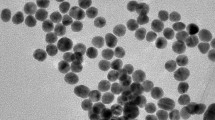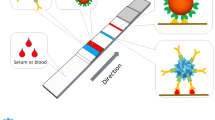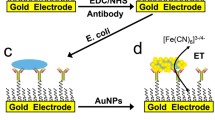Abstract
A fluorescent quantum dot-based antibody array, used in sandwich format, has been developed to detect Escherichia coli O157:H7. Numerous parameters such as solid support, optimal concentration of immunoreagents, blocking reagents, and assay time were optimized for array construction. Quantum dot-conjugated anti-IgG was used as the detecting system. The array allows the detection of E. coli O157:H7 at concentrations below 10 CFU mL−1 without sample enrichment, exhibiting an increase of three orders of magnitude in the limit of detection compared to ELISA. The interference caused by Gram (+) and Gram (−) bacteria was negligible at low concentrations of bacteria.






Similar content being viewed by others
References
Bell C (2002) Approach to the control of entero-haemorrhagic Escherichia coli (EHEC). Int J Food Microbiol 78:197–216
Griffin PM, Tauxe RV (1991) The epidemiology of infections caused by Escherichia coli O157:H7, other enterohemorrhagic E. coli, and the associated hemolytic uremic syndrome. Epidemiol Rev 13:60–98
Dorn CR, Angrick EJ (1991) Serotype O157:H7 Escherichia coli from bovine and meat sources. J Clin Microbiol 29:1225–1231
Hrudey SE, Payment P, Huck PM, Gillham RW, Hrudey EJ (2003) A fatal waterborne disease epidemic in Walkerton, Ontario: comparison with other waterborne outbreaks in the developed world. Water Sci Technol 47:7–14
Mead PS, Griffin PM (1998) Escherichia coli O157:H7. Lancet 352:1207–1212
Allen MJ, Edberg SC, Reasoner DJ (2004) Heterotrophic plate count bacteria—what is their significance in drinking water? Int J Food Microbiol 92:265–274
Van Dyck E, Ieven M, Pattyn S, Van Damme L, Laga M (2001) Detection of Chlamydia trachomatis and Neisseria gonorrhoeae by enzyme immunoassay, culture, and three nucleic acid amplification tests. J Clin Microbiol 39:1751–1756
Manafi M, Kremsmaier B (2001) Comparative evaluation of different chromogenic/fluorogenic media for detecting Escherichia coli O157:H7 in food. Int J Food Microbiol 71:257–262
Hansen WL, Beuving J, Bruggeman CA, Wolffs PF (2010) Molecular probes for the diagnosis of clinically relevant bacterial infections in blood cultures. J Clin Microbiol 48(12):4432–4438
Dharmasiri U, Witek MA, Adams AA, Osiri JK, Hupert L, Bianchi S, Roelke DL, Soper SA (2010) Enrichment and detection of Escherichia coli O157:H7 from water samples using an antibody modified microfluidic chip. Anal Chem 82:2844–2849
Ligler FS, Sapsford KE, Golden JP, Shriver-Lake LC, Taitt CR, Dyer MA, Barone S, Myatt C (2007) The array biosensor: portable, automated systems. Anal Sci 23:5–10
Angenendt P (2005) Progress in protein and antibody microarray technology. Drug Discov Today 10:503–511
Wingren C, Borrebaeck CA (2009) Antibody-based microarrays. Meth Mol Biol 509:57–84
Gehring AG, Albin DM, Bhunia AK, Reed SA, Tu SI, Uknalis J (2006) Antibody microarray detection of Escherichia coli O157:H7: quantification, assay limitations, and capture efficiency. Anal Chem 78:6601–6607
Kim JS, Anderson GP, Erickson JS, Golden JP, Nasir M, Ligler FS (2009) Multiplexed detection of bacteria and toxins using a microflow cytometer. Anal Chem 81:5426–5432
Karoonuthaisiri N, Charlermroj R, Uawisetwathana U, Luxananil P, Kirtikara K, Gajanandana O (2009) Development of antibody array for simultaneous detection of foodborne pathogens. Biosens Bioelectron 24:1641–1648
Wolter A, Niessner R, Seidel M (2008) Detection of Escherichia coli O157:H7, Salmonella typhimurium, and Legionella pneumophila in water using a flow-through chemiluminescence microarray readout system. Anal Chem 80:5854–5863
Karsunke XY, Niessner R, Seidel M (2009) Development of a multichannel flow-through chemiluminescence microarray chip for parallel calibration and detection of pathogenic bacteria. Anal Bioanal Chem 395:1623–1630
Mukundan H, Xie H, Anderson AS, Grace WK, Shively JE, Swanson BI (2009) Optimizing a waveguide-based sandwich immunoassay for tumor biomarkers: evaluating fluorescent labels and functional surfaces. Bioconjug Chem 20:222–230
Herman RA, Scherer PN, Shan G (2008) Evaluation of logistic and polynomial models for fitting sandwich-ELISA calibration curves. J Immunol Meth 339:245–258
Long GL, Winefordner JD (1983) Limit of detection: a closer look at the IUPAC definition. Anal Chem 55:712–724
Olle EW, Messamore J, Deogracias MP, Mcclintock SD, Anderson TD, Johnson KJ (2005) Comparison of antibody array substrates and the use of glycerol to normalize spot morphology. Exp Mol Pathol 79:206–209
Gokarna A, Jin LH, Hwang JS, Cho YH, Lim YT, Chung BH, Youn SH, Choi DS, Lim JH (2008) Quantum dot-based protein micro- and nanoarrays for detection of prostate cancer biomarkers. Proteomics 8:1809–1818
Macbeath GS, Schreiber SL (2000) Printing proteins as microarrays for high-throughput function determination. Science 289:1760–1763
Hanaki K, Momo A, Oku T, Komoto A, Maenosono S, Yamaguchi Y, Yamamoto K (2003) Semiconductor quantum dot/albumin complex is a long-life and highly photostable endosome marker. Biochem Biophys Res Commun 302:496–501
Geho D, Lahar N, Gurnan IP, Huebschman M, Herrmann P, Espina V, Shi A, Wulfkuhle J, Garner H, Petricoin ER, Liotta LA, Rosenblatt KP (2005) Pegylated, steptavidin-conjugated quantum dots are effective detection elements for reverse-phase protein microarrays. Bioconjug Chem 16:559–568
Rousserie G, Sukhanova A, Even-Desrumeaux K, Fleury F, Chames P, Baty D, Oleinikov V, Pluot M, Cohen JH, Nabiev I (2010) Semiconductor quantum dots for multiplexed bio-detection on solid-state microarrays. Crit Rev Oncol Hematol 74:1–15
Park TJ, Yoo SM, Keum KC, Lee S (2009) Microarray of DNA-protein complexes on poly-3-hydroxybutyrate surface for pathogen detection. Anal Bioanal Chem 393:1639–1647
Jaing C, Gardner S, Mcloughlin K, Mulakken N, Alegria-Hartman M, Banda P, Williams P, Gu P, Wagner M, Manohar C, Slezak T (2008) A functional gene array for detection of bacterial virulence elements. PLoS ONE 3:e2163
Miller MB, Tang YW (2009) Basic concepts of microarrays and potential applications in clinical microbiology. Clin Microbiol Rev 22:611–633
Uttamchandani M, Neo JL, Ong BN, Moochhala S (2009) Applications of microarrays in pathogen detection and biodefence. Trends Biotechnol 27:53–61
Seurynck-Servoss SL, White AM, Baird CL, Rodland KD, Zangar RC (2007) Evaluation of surface chemistries for antibody microarrays. Anal Biochem 371:105–115
Gonzalez RM, Seurynck-Servoss SL, Crowley SA, Brown M, Omenn GS, Hayes DF, Zangar RC (2008) Development and validation of sandwich ELISA microarrays with minimal assay interference. J Proteome Res 7:2406–2414
Hahn MA, Tabb JS, Krauss TD (2005) Detection of single bacterial pathogens with semiconductor quantum dots. Anal Chem 77:4861–4869
Liu Y, Brandon R, Cate M, Peng X, Stony R, Johnson M (2007) Detection of pathogens using luminescent CdSe/ZnS dendron nanocrystals and a porous membrane immunofilter. Anal Chem 79:8796–8802
Yang L, Li Y (2006) Simultaneous detection of Escherichia coli O157:H7 and Salmonella typhimurium using quantum dots as fluorescence labels. Analyst 131:394–401
Zhao Y, Ye M, Chao Q, Jia N, Ge Y, Shen H (2009) Simultaneous detection of multifood-borne pathogenic bacteria based on functionalized quantum dots coupled with immunomagnetic separation in food samples. J Agric Food Chem 57:517–524
Su XL, Li Y (2004) Quantum dot biolabeling coupled with immunomagnetic separation for detection of Escherichia coli O157:H7. Anal Chem 76:4806–4810
Magliulo M, Simoni P, Guardigli M, Michelini E, Luciani M, Lelli R, Roda A (2007) A rapid multiplexed chemiluminescent immunoassay for the detection of Escherichia coli O157:H7, Yersinia enterocolitica, Salmonella typhimurium, and Listeria monocytogenes pathogen bacteria. J Agric Food Chem 55:4933–4939
Acknowledgments
CIBER-BBN is an initiative funded by the VI National R&D&i Plan 2008-2011, Iniciativa Ingenio 2010, Consolider Program, CIBER Actions and financed by the Instituto de Salud Carlos III with assistance from the European Regional Development Fund.
Author information
Authors and Affiliations
Corresponding author
Rights and permissions
About this article
Cite this article
Sanvicens, N., Pascual, N., Fernández-Argüelles, M.T. et al. Quantum dot-based array for sensitive detection of Escherichia coli . Anal Bioanal Chem 399, 2755–2762 (2011). https://doi.org/10.1007/s00216-010-4624-5
Received:
Revised:
Accepted:
Published:
Issue Date:
DOI: https://doi.org/10.1007/s00216-010-4624-5




